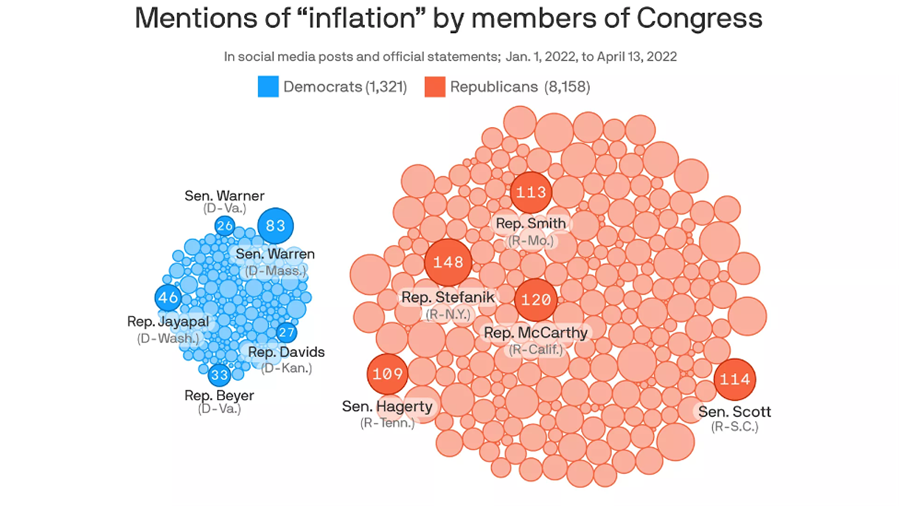Campaign Quick Hits
Not Great, Bob: Last week, Cook Political Report moved eight Democratic-held House seats toward the Republican column. “With these changes, there are 27 Democratic seats in Toss Up or worse, and that list is certain to grow longer when Florida and New Hampshire finalize their lines,” Dave Wasserman announced. “By contrast, there are only 12 GOP-held seats in Toss Up or worse – all of which are due to redistricting, not atmospheric factors.”
Six months is a long time, but it’s not that long. At some point, national Democrats will need to let the House go and move resources to focus on keeping the Senate. Losing the House may end legislative dreams, but losing the Senate means the end of judicial and Cabinet confirmations. If anything I’m surprised we haven’t heard about more Democratic spending in some of these Republican Senate primaries (a la when Democratic Sen. Claire McCaskill bragged about helping Todd “legitimate rape” Akin secure the Republican nomination in 2014) to boost a less palatable candidate in states like Missouri, Ohio, and Pennsylvania, which would give Democrats a chance of a surprise pickup in an otherwise bleak cycle.
Picture of the Day: Gee, I wonder what Republicans are running on in 2022 …

How Are Crossover Districts Shaping Up? Ahead of the midterm elections, election analysts always keep their eyes on crossover districts—districts that went for a Democratic House candidate and the GOP presidential nominee, or vice versa. As Audrey and Harvest reported in February, the number of crossover districts “has shrunk every presidential election cycle since 1984, when 190 members—or 43.7 percent of the House’s 435 members—were elected in crossover districts.” In 2020, that number fell to 16.
We caught up with J. Miles Coleman from Sabato’s Crystal Ball to hear more about how the five Democratic incumbents from crossover districts might fare in 2022, especially since many election analysts are predicting a red wave in the midterms. “There were close to 50 Democrats who held districts that John McCain had won in ‘08. Only a dozen of them were re-elected in 2010,” Coleman said in an interview. “By a sort of similar token, in 2018, there were 23 Republicans who had Clinton seats. And of course, really in 2018, the backlash towards Trump hit kind of hardest in the House.” Only three of those Republicans were re-elected that year.
(Correction: The original version of this story incorrectly stated that there are seven House Democrats from crossover districts seeking reelection.)
Can NYC’s Lone House Republican Keep Her Seat? One district we’re keeping a close eye on this midterm cycle is New York’s 11th, currently held by vulnerable GOP Rep. Nicole Malliotakis. In 2020, she defeated former Democratic Rep. Max Rose by roughly 6 points. It’s not a crossover district—Trump won the district by roughly 10 points that year.
But it’s a redistricting year, and New York’s new map makes it a much tougher race than originally expected. The conservative Staten Island borough will now be paired with Brooklyn’s liberal Park Slope neighborhood, as explained in this great story by the New York Times’ Katie Glueck in February.
“Now it’s Biden plus-9,” Coleman said. “She could potentially hold on if it’s a good enough year for the Republicans.” But it’ll be an uphill climb—Sabato’s Crystal Ball currently rates it as a toss-up.
Missouri Senate: A Close Field Awaits Trump’s Endorsement
In Republican primaries across the country this year, one main storyline is playing out again and again: How much influence does Donald Trump, still stinging from his 2020 loss and eager to purge the GOP of the insufficiently loyal, still wield over the party’s primary electorate? It’s an important question in general, but it’s particularly interesting in how it intersects with each race’s unique on-the-ground storylines and characteristics. Take a look, for example, at the crowded GOP Senate primary in Missouri, where Trump has yet to pick a horse and a clear frontrunner has yet to emerge. In recent polling, state Attorney General Eric Schmitt, U.S. Rep. Vicky Hartzler, and former Gov. Eric Greitens are all polling in the low 20s. Rep. Billy Long comes in fourth on the wrong side of 10 percent.
For most of the early race, the strongest-seeming candidate was Greitens—something of a surprise, given Greitens resigned from the governorship in disgrace just four years ago after an extramarital affair that allegedly involved sexual abuse and blackmail. His spasmodic attempts to survive that scandal also made an enemy of Josh Hawley, then his attorney general and now the senator Greitens is running to serve alongside.
When he set his eyes on the Senate, however, Greitens set about rehabilitating his image among Republican voters with a vengeance, making regular appearances on MAGA platforms (Steve Bannon’s podcast, Tucker Carlson’s show) to badmouth Democrats and “RINOs” like Senate Minority Leader Mitch McConnell and to insist that the campaign against him had been a politically motivated media witch hunt. That narrative, coupled with field-beating name ID and a core of diehards who thought he’d been railroaded all along, helped Greitens lead in every poll between last summer and this February.
Two things Donald Trump likes are winners and outsiders, and three things he hates are Democrats, the media, and Mitch McConnell. So by last month, despite a chorus of frantic Republicans arguing that Greitens was damaged goods who could fritter away a safe November general election, it seemed Trump might be warming to the former governor. In late February, Politico’s Alex Isenstadt reported, Trump took a private meeting at Mar-a-Lago with Greitens; days later, Trump’s Save America PAC emailed out a recent column Greitens had written for Breitbart attacking McConnell’s leadership. Were an endorsement to follow, it might have been enough to put Greitens over the top.
But just weeks later, Greitens was hit with a new scandal: His ex-wife Sheena Greitens, who filed for divorce in 2020, accused him in a court filing of “unstable and coercive behavior” as his political career was falling apart in 2018 that included “physical violence” against her and their two young children. The filing alleged Sheena Greitens had photos and other evidence to support the accusations.
Greitens hit back with characteristic good taste, calling his ex-wife a “deranged individual” with “a documented history of mental illness and emotionally abusive behavior.” But the new allegations seemingly dampened Trump’s growing interest—a few days later, Trump sent out a statement pondering whether Missouri voters were considering “the big, loud, and proud personality of Congressman Billy Long,” whom he praised as “a warrior.”
“This is not an endorsement,” Trump concluded, “but I’m just askin’?”
Just askin’ is unlikely to be enough to push Long into the top tier, but Trump’s uncharacteristically polite sidelining of Greitens may well accelerate the former governor’s slump. Regardless, it has left the race as anybody’s game—and opened some new lines of political attack.
Take, for instance, an ad Hartzler put up last week in response to a Greitens attack ad that said that she had “backed a plan to grant amnesty to more than 1 million” illegal immigrants.
“It’s a lie from Eric Greitens—that’s what he does,” Hartzler says in the ad. The bill in question, she points out, was endorsed by Trump, and included funding for the border wall and a crackdown on sanctuary cities, among other things. “If Eric Greitens had any honor left, he’d apologize to President Trump—and maybe a few other people too.” It’s not the sort of language you’d expect to hear if Hartzler were still worried a Greitens endorsement was inbound from Mar-a-Lago.
Any ground lost by Greitens will be particularly hard to make up given his campaign’s relative poverty. At the end of the Q1 filing period, Greitens had only $345,000 on hand, with nearly half as much in loans owed by his campaign committee. Schmitt, by contrast, has a war chest of $1.3 million; Hartzler, $1.5 million.
Harvest Prude wrote an impressive piece on what the redistricting wars look like from the perspective of a state that thought they had ended partisan gerrymandering but finds themselves with no map at all.
A Redistricting Mess in the Buckeye State
The Ohio Redistricting Commission, a Republican-dominated body, is in a months-long standoff with the state Supreme Court. Since last September, the commission—and Ohio lawmakers—have voted to approve four different maps submitted by the commission. But each time, the state Supreme Court has rejected them as unconstitutional.
Ohio Secretary of State Frank LaRose opted to go forward with the May 3 primary, saying that one of the versions of the commission’s congressional maps is valid to use. But the legislative races for the Ohio Senate and Ohio House of Representatives, as well as some other local races, must wait to appear on a second primary ballot later in the year, once the legislative maps are finalized. The second primary will cost the state millions of dollars.
The fight over redistricting has created headaches for candidates, confused voters, and appalled good governance advocates—especially because it comes on the heels of ballot referendums, overwhelmingly passed by Ohio voters, that were designed to squelch partisan gerrymandering in the state.
In 2015, voters approved a measure creating a bipartisan commission to draw legislative districts. In 2018, they approved a measure establishing a similar process for drawing congressional maps. It also amended the state constitution to require that the redistricting process include bipartisan cooperation and that maps must not favor one political party. The measure also established that a supermajority of the Ohio legislature must approve the maps—else they would be good for only for four years instead of 10.*
But in four rulings this year, the state’s seven-member Supreme Court has called the maps unconstitutional, with Republican Chief Justice Maureen O’Connor siding with the court’s three Democrats. The court has ordered the redistricting commission to produce a fifth set of maps by May 6 that will pass constitutional muster, but hopes are fading.
…
Nationally, the current redistricting cycle is yielding maps that look relatively balanced.
Republicans control 62 state legislative chambers, while Democrats control 36. In Alaska, control of the House is in the hands of a coalition. (Nebraska’s legislative branch is unicameral, but members are elected on a nonpartisan basis.) Republicans are also in charge of drawing 187 congressional districts, while Democrats have control of 75 this cycle. But despite this lopsided control, Democrats are not suffering heavy losses when it comes to districts’ partisan leanings.
In fact, according to an analysis by FiveThirtyEight, Democratic-leaning seats will increase by a net of 11 in comparison with the old maps. Meanwhile, Republican-leaning seats have dropped by six. (That’s just a comparison of the partisan lean of the seats, the analysis notes. It does not factor in incumbency and is also unlikely to dampen the good position Republicans are in to do well in the 2022 midterm elections.)
FiveThirtyEight’s analysis concludes that there will be around 220 to 223 Republican-leaning seats in the next Congress, and 212 to 215 Democratic-leaning seats.
But a closer look at individual states reveals patent gerrymandering. Democratic mapmakers in New York have gerrymandered very aggressively, while Republicans have done the same in Texas.
The number of competitive seats has declined across the country—with FiveThirtyEight’s analysis noting that highly competitive districts have declined by around five. While some of the map remains unsettled, FiveThirtyEight predicted that this cycle of mapmaking could result in the fewest swing districts since 1996.
Read the rest of Harvest’s redistricting extravaganza here.
Audrey wrote a story for the site on GOP candidate Joe Kent’s drama-filled attempt to unseat six-term incumbent Jaime Herrera-Beutler, who voted to impeach the former president last year. Here’s a sneak peek.
Internal Strife and External Criticism Rile Joe Kent’s Campaign
In September, Donald Trump-endorsed congressional candidate Joe Kent told The Dispatch that “election integrity” is his “number one” campaign issue in his bid to unseat six-term GOP Rep. Jaime Herrera Beutler in Washington’s 3rd Congressional District.
But his former campaign manager Byron Sanford says that if Kent is truly focused on election integrity, he should start with his own campaign.
In early April, Sanford told The Dispatch that days before Kent fired him in early December, Kent’s then-field director and now campaign manager Ozzie Gonzalez texted him via the encrypted messaging app Signal about his plans to use cigarettes and pizza to register homeless people and undocumented immigrants to vote, then sort through their ballots to ensure they chose Joe Kent as their desired candidate.
The right-wing blog Red Voice Media first published screenshots of the texts on Thursday, writing that “the allegations against Kent are both heavy and concerning,” although the article does not detail any in-depth verification process reporters typically use to independently authenticate text messages. The campaign offered Red Voice Media no formal comment on the allegations beyond Gonzalez’s assurance that “off the record right now, there’s no validity to them.”
The campaign wasn’t as close-lipped when speaking with The Dispatch earlier this month. “We’ve been through this before,” Kent, a square-jawed former Green Beret, CIA operations officer, and Gold Star husband, said in an interview on April 9 whenasked about the texts and Sanford. “This is why I got rid of the guy—I just simply couldn’t trust him.” Both Kent and Gonzalez claim the messages are fake.
It was in the process of attempting to verify the authenticity of the Signal messages that The Dispatch discovered the drama within the Kent campaign: Gonzalez, the brains behind the alleged scheme, insists Sanford’s claims are invented. Sanford, the fired campaign manager, admitted to falsely accusing the Kent campaign of doctoring other Signal messages to hurt his reputation.
The disputed text messages are issues inside the campaign. Externally, Kent has faced criticism for ties to white nationalists and come under fire for views he has expressed on foreign policy. He’s hoping Trump’s assurance to voters that “Joe will be a warrior for the America First agenda” will get him across the finish line.
Read the rest of Audrey’s story here.












Please note that we at The Dispatch hold ourselves, our work, and our commenters to a higher standard than other places on the internet. We welcome comments that foster genuine debate or discussion—including comments critical of us or our work—but responses that include ad hominem attacks on fellow Dispatch members or are intended to stoke fear and anger may be moderated.